Affiliate links on Android Authority may earn us a commission. Learn more.
Best of Android 2016: Battery
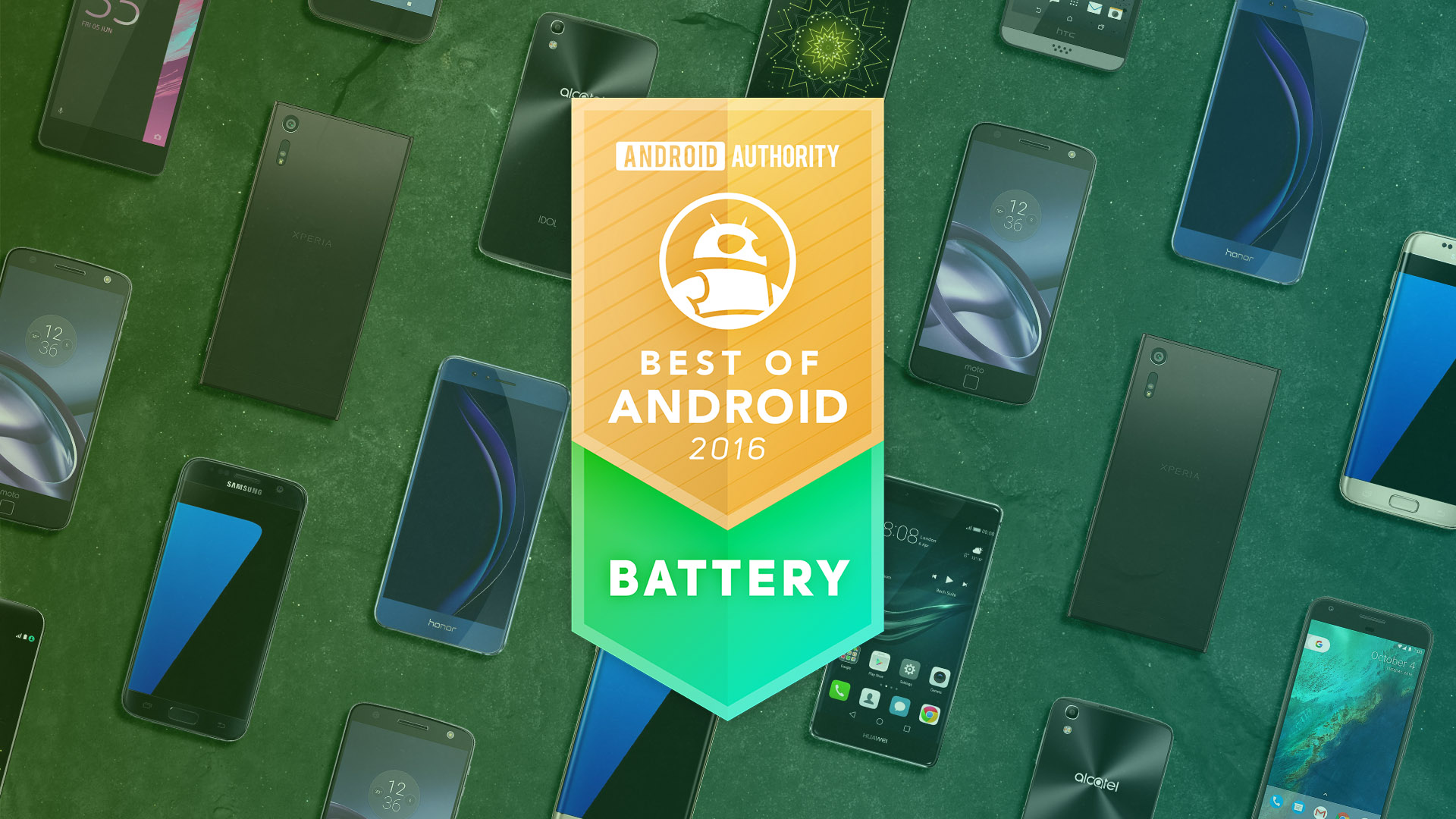
What is Best of Android?
In Best of Android, we take the most important smartphones of the year and compare them side-by-side and in-depth. This year, with so many good phones available, we've stepped things up a notch and brought the 10 biggest Android phones of the year to the competition.
- Samsung Galaxy S7 Edge
- HTC 10
- Sony Xperia XZ
- Google Pixel XL
- Xiaomi Mi 5
- Lenovo Moto Z Force Droid
- OnePlus 3T
- LG V20
- HUAWEI Mate 9
- ZTE Axon 7
Read more about Best of Android and thanks for being such a valuable part of the Android Authority family!
If you’re anything like us, you constantly get asked “what is the best phone?” and “which Android phone has the best battery life?” Rather than relying on the infamous “moderate-to-heavy usage” yardstick, we’re getting technical.
You will have undoubtedly read the battery section in each device’s full review throughout the year, but Best of Android 2016 puts them all side-by-side through a series of specially calibrated Android Authority tests using our own custom battery tests and benchmarks, so you can compare apples and apples.
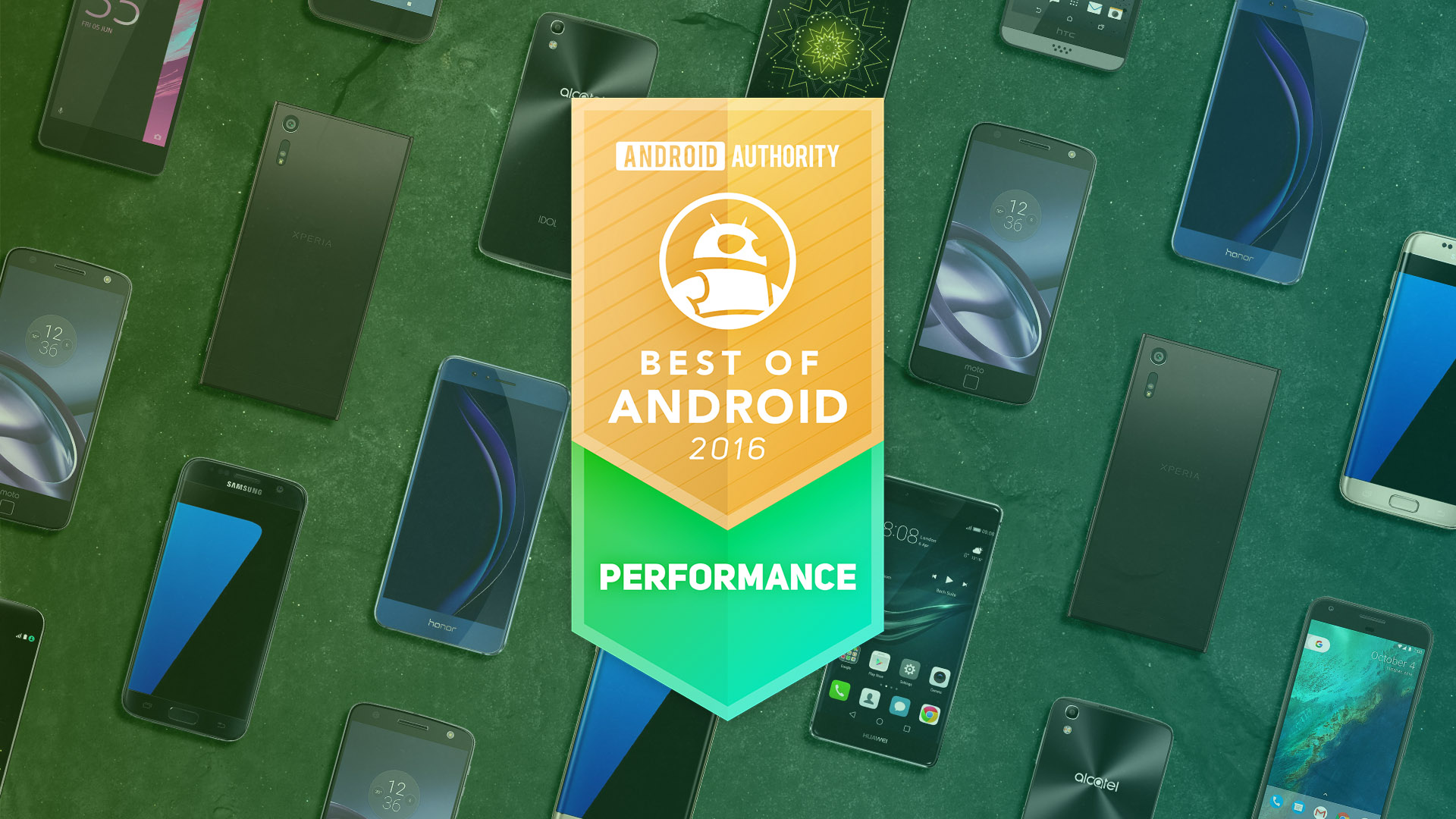
The tests include our custom “general” battery test, comprising a variety of different tasks aimed at replicating average daily usage. We also have dedicated battery tests for Wi-Fi browsing, gaming and video playback, along with a battery recharge test because we know just how important fast charging has become.
There’s no guesswork to interpret here, just cold, hard data to reveal the true lay of the land. Each device was ranked for each individual test with those scores averaged out at the end to declare our overall winner. But first, lets get our hands dirty in each tested category. For reference, here are the actual battery capacities of each tested device:
| HUAWEI Mate 9 | 4,000 mAh | ZTE Axon 7 | 3,250 mAh |
| Samsung Galaxy S7 Edge | 3,600 mAh | LG V20 | 3,200 mAh |
| Moto Z Force Droid | 3,500 mAh | HTC10 | 3,000 mAh |
| Google Pixel XL | 3,450 mAh | Xiaomi Mi 5 | 3,000 mAh |
| OnePlus 3T | 3,400 mAh | Sony Xperia XZ | 2,900 mAh |
Charging time
When it comes to charging times there are two main things to consider: the capacity of the battery and the charging tech involved. All things being equal, a smaller battery will charge faster than a larger battery (although all batteries charge faster at the beginning and slow down as they near a full charge). But each manufacturer also has their own custom fast charging tech, some of which is better than others. So, to keep things on an even keel, we’ve ranked our devices in two different ways.
The first is obvious: which device charged fastest, regardless of how large its battery cell is. This is the “real world” test. The second takes a more apples-to-apples approach so you can tell which device’s battery charges faster pound-for-pound. Based on the time taken in the real world test, we calculated the charge rate for each device, so you can see a relative comparison per unit of battery capacity, kind of like miles per gallon for your car. All tests were conducted using the supplied charger.
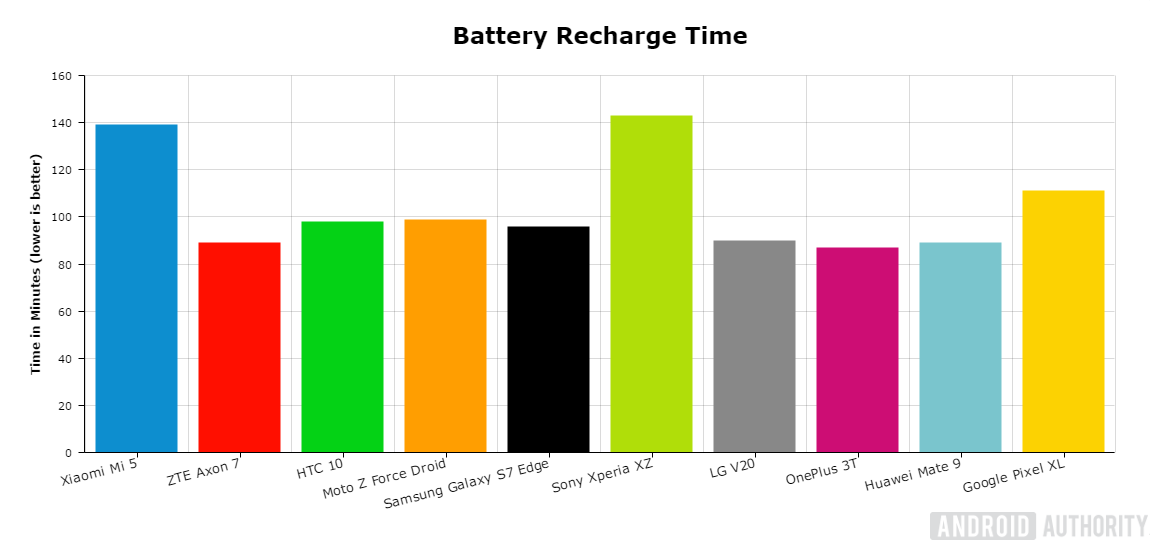
In 2016, the fastest phone to charge a full battery was the OnePlus 3T with its phenomenal Dash Charge tech. The 3T’s 3,400 mAh battery took just 87 minutes to charge completely. Second place was tied at 89 minutes, with the HUAWEI Mate 9 and ZTE Axon 7 sharing the podium, but considering the Mate 9 has a 4,000 mAh battery compared to the Axon 7’s 3,250 mAh capacity, the Mate 9 clearly has the edge. The LG V20 took fourth place, taking 90 minutes to charge its 3,200 mAh battery.
On the slow side of things, the Sony Xperia XZ won on all counts: the smallest battery that took the longest time to charge (2,900 mAh in 143 minutes). However, this is primarily due to the XZ coming with a standard 1.5A charger in the box rather than a fast charger that supports Qualcomm Quick Charge. The Xiaomi Mi 5 wasn’t far behind though, taking 139 minutes to charge its 3,000 mAh cell and it does have a Quick Charge 3.0 charger in the box.
As promised we also calculated how many mAh each device could charge in a standard time, in this case, one minute. This lets you know which device has the most efficient battery charger. The winner? The Mate 9, which juiced up 45 mAh per minute on average (remember, batteries charge slower as they near completion). The One Plus 3T was next, with 39 mAh/minute, followed by the S7 Edge with 37.5 mAh/minute and the Axon 7 with 36.5 mAh/minute. Not surprisingly, the slowest rates were the XZ (20 mAh/minute) and Mi 5 (21.5 mAh/minute).
Use time (Wi-Fi browsing)
The first benchmark test we ran was Wi-Fi browsing. Our Wi-Fi test repeatedly loads a selection of webpages until the battery goes from 100% to zero. Device displays are set to 200 nits brightness and pages are loaded over Wi-Fi with airplane mode enabled. Auto-updates and any battery saver modes are also disabled during the test.
Wi-Fi browsing isn’t such a taxing task, so we saw some pretty epic battery durations. Best of all though was the HUAWEI Mate 9 and it’s massive 4,000 mAh battery (the largest on our list) which managed to keep the lights on for an impressive 14 hours and four minutes.
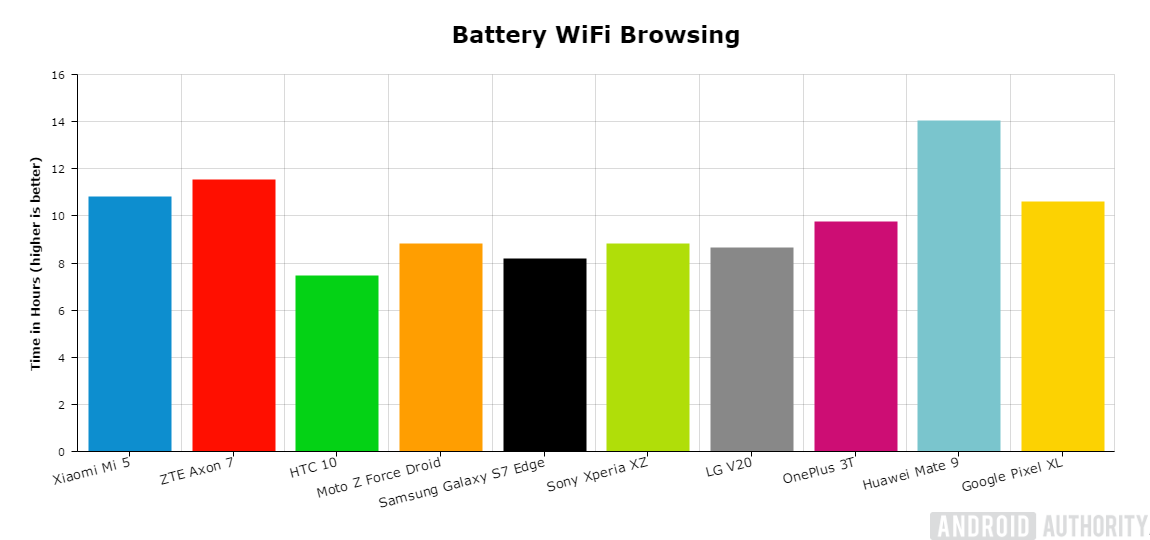
In second spot was the ZTE Axon 7 (3,250 mAh) with 11 and a half hours of browsing time, followed by the Xiaomi Mi 5 (3,000 mAh) and the Google Pixel XL (3,450 mAh) at around 10 and three quarter hours.
Interestingly, the device with the second largest battery capacity on our list – the Galaxy S7 Edge with a 3,600 mAh battery – came in second last, with just 8 hours and 11 minutes of web browsing before shutting down. But the HTC10 was the worst of all with just shy of 7 hours and a half hours of browsing time.
Use time (gaming)
The next benchmark tests battery life for gaming. Games tax battery life more than browsing due to the enhanced graphical demands. Our test runs Epic Citadel, a 3D gaming simulation on a device with a fully charged battery on 200 nits brightness until the battery is depleted. The simulations run at the maximum resolution of the device (so keep that in mind when comparing devices with Full HD resolution versus QHD).
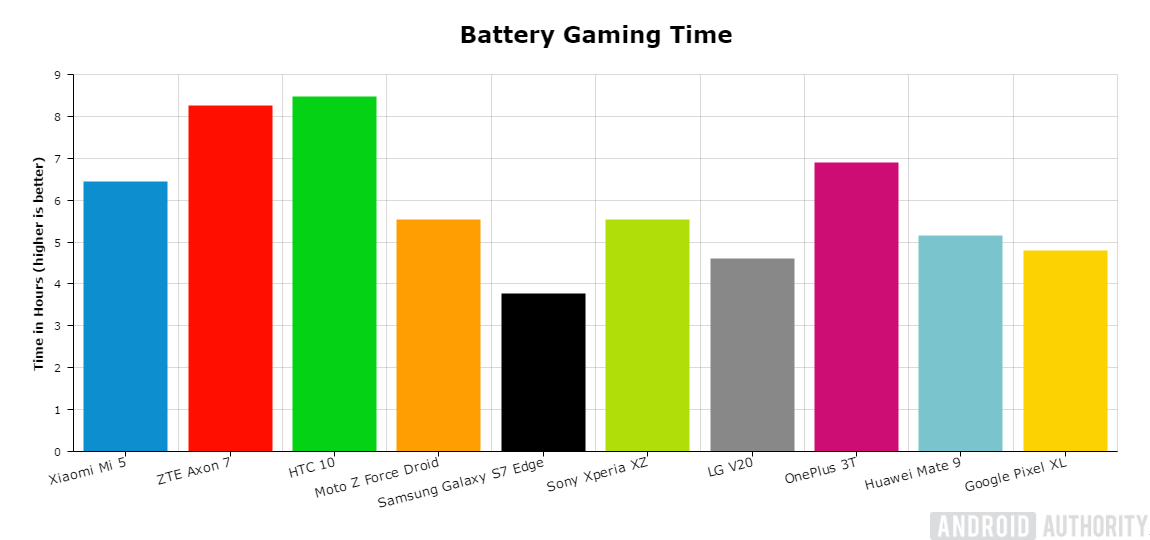
3D gaming is amongst the most demanding tasks you can ask of your smartphone, but some phones are better equipped to handle those demands than others. In this test, our best battery duration was the HTC10 with 8 hours and 29 minutes. A very impressive feat, especially considering the HTC10 came in dead last on the Wi-Fi browsing test.
Second place went to the ZTE Axon 7 with 8 hours and 15 minutes, followed by the OnePlus 3T just short of 7 hours and the Xiaomi Mi 5 with just under 6 and a half hours. The Galaxy S7 Edge had the worst gaming performance of all, with just 3 hours and 46 minutes.
Use time (video playback)
Our last dedicated battery test is for video playback, perhaps the most common way to deplete your battery by doing just one thing. As you have probably guessed, our test runs an endless loop of video to see how long each device lasts before the battery runs from full to empty. The Full HD video file at 23.9fps, was stored locally and Wi-Fi was turned off.
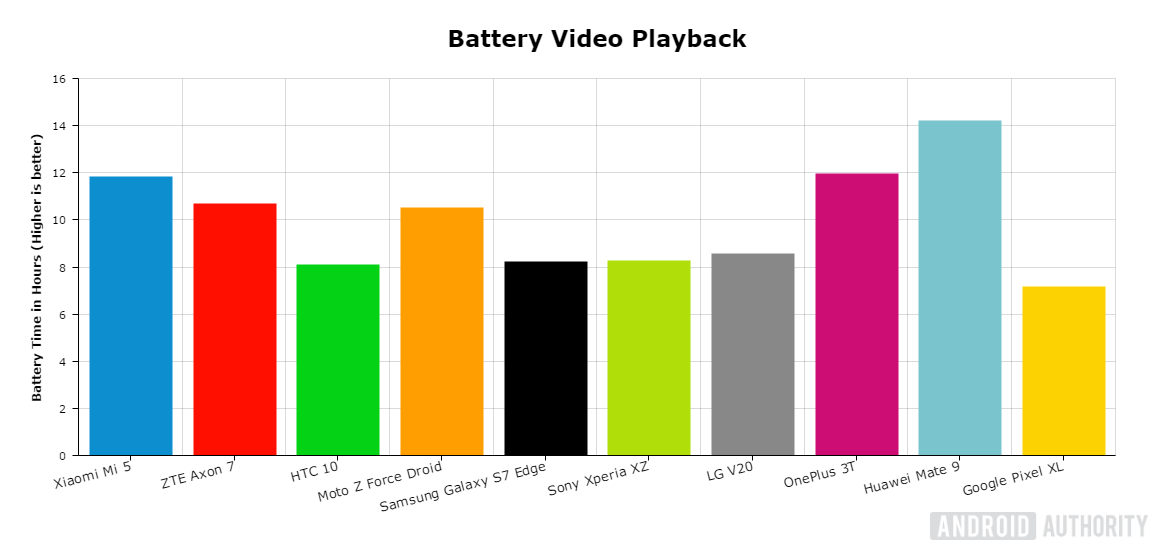
This test resulted in similar, but not identical, results to the Wi-Fi browsing test. The HUAWEI Mate 9 took first place, with 14 hours and 12 minutes, followed by the OnePlus 3T with just under 12 hours and the Xiaomi Mi 5 with 11 hours and 51 minutes. The worst performer here was the Google Pixel XL, which barely limped past 7 hours of video playback despite having the fourth largest battery of the bunch and the newest version of Android.
General battery test
Our general battery test uses a combination of the above three dedicated tests and extrapolates run time based on “general” usage. Of course, your mileage may vary, but because the test is identical on each device, it gives a good indication of how well each phone handles a variety of tasks. As you can probably tell from the results above, different devices excel at different tasks, so this test is designed to provide an “all-rounder” rating.
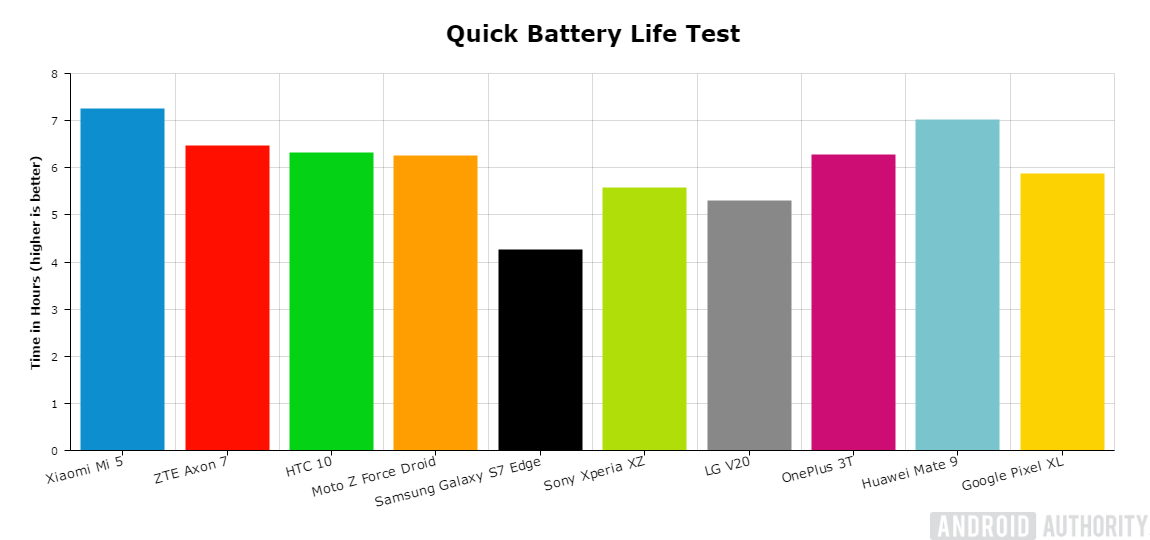
In the general usage test, the results were a lot closer. The Xiaomi Mi 5 ultimately came out on top with 7 and a quarter hours, with the HUAWEI Mate 9 hot on its tail with just over 7 hours. But considering the Mate 9 has a 33 percent larger battery than the Mi 5, the Mi 5’s dominance in this category is even more impressive.
Third place went to the Axon 7, followed by a cluster of devices with very similar run times: the HTC10, OnePlus 3T and the Moto Z Force Droid. The weakest performer was the Galaxy S7 Edge with 4 and a quarter hours.
Wrap up
While it’s interesting to know how each device performs on an even playing field, the fact of the matter is that all batteries aren’t created equal. Some devices have larger batteries, some have faster charging tech and some have better software optimizations for prolonging battery life. So, given the tests we ran on each device and the combined results, which Android smartphone has the best all-round battery in 2016?
The HUAWEI Mate 9
The HUAWEI Mate 9 has the largest battery of all the tested devices, but it also has the fastest per-minute charge rate and very good all-round performance. It’s clearly your best bet if you spend a lot of time watching videos or browsing the web, but hardcore mobile gamers are probably better off looking elsewhere. Second place overall went to the excellent ZTE Axon 7 and the OnePlus 3T’s battery bump helped it score third spot.
| 1. HUAWEI Mate 9 | 8.6 | 6. HTC10 | 4.6 |
| 2. ZTE Axon 7 | 8.0 | 7. Google Pixel XL | 3.8 |
| 3. OnePlus 3T | 7.6 | 7. LG V20 | 3.8 |
| 4. Xiaomi Mi 5 | 7.0 | 9. Sony Xperia XZ | 3.6 |
| 5. Lenovo Moto Z Force Droid | 4.8 | 10. Samsung Galaxy S7 Edge | 3.2 |
A note on results: Our overall battery scores were calculated by assigning points between 1-10 to each device in each category. The best performer scored 10 points, second place 9 points and so on, regardless of how close the margin was. Those category scores were then averaged for the final grading you see above.
Keep in mind that there are a whole bunch of factors at play when considering battery life: screen brightness, stability of your network connections, display resolution, whether GPS and location sharing are on, screen timeout settings, battery capacity, Android version, battery saving modes, background processes, syncing, auto-updates and so on. Each user will have different habits that greatly affect their battery mileage.
Of course, you may not be a gamer or perhaps you never watch videos on your phone. In these cases, our overall winner based on equally weighting each test may not be compatible with your particular needs or preferences. If so, just take a closer look at the categories that do apply to your usage habits and draw your conclusions from there.
Want the best phone for gaming? Get the ZTE Axon 7. The best phone for watching YouTube videos or browsing? Then you’ll want the Mate 9. The phone you can juice up the fastest as you rush out the door? The OnePlus 3T, and so on. Thanks for reading and be sure to check out the other categories in the Best of Android 2016 series.
Credits
Tested by: Gary Sims, Andrew Grush, Nirave Gondhia, John Velasco, Joshua Vergara, Lanh Nguyen
Series Contributors: Rob Triggs, Edgar Cervantes, Kris Carlon
Series Editors: Nirave Gondhia, Bogdan Petrovan, Andrew Grush